
Soviet television reconnaissance satellitesby Bart Hendrickx
|
| With the film readout technique offering little promise, the Soviet designers decided to pursue a different path to speed up the return of reconnaissance imagery, namely to outfit spy satellites with television cameras. |
A similar film readout system tested by a US Air Force Samos reconnaissance satellite in 1961 suffered the same fate (although the technology was transferred to NASA for use in the Lunar Orbiter program). Later in the decade, the Pentagon gave approval for a film readout version of the GAMBIT spy satellites known as Film Read-Out GAMBIT or FROG.[2] In 1971 it was canceled in favor of the first electro-optical reconnaissance satellite, which saw its inaugural flight in 1976 under the code name KENNEN.
With the film readout technique offering little promise, the Soviet designers decided to pursue a different path to speed up the return of reconnaissance imagery, namely to outfit spy satellites with television cameras. The United States had pioneered this technology with TIROS-1, the world’s first meteorological satellite, launched in April 1960. TIROS had actually evolved from a proposal for a reconnaissance satellite which had been rejected because the resolution of TV cameras was inferior to that of photographic camera systems.
The initiative to develop television-based reconnaissance satellites reportedly came from Vladimir Chelomei, the head of the OKB-52 design bureau. Having initially specialized in anti-ship cruise missiles, it branched out into rockets and military satellites in the late 1950s and early 1960s. According to one source, Chelomei managed to convince Soviet leader Nikita Khrushchev that he could develop a satellite system capable of beaming TV images of critical regions directly to the Kremlin.[3] Matters of concern to the Soviet Union at the time were the deployment of American Minuteman intercontinental ballistic missiles and Polaris submarine-launched ballistic missiles, as well as the presence of an impressive fleet of US strategic bombers, many of which patrolled the borders of the Soviet Union round the clock. If there were any signs of an imminent attack, the response would have to be quick.
On September 4, 1963 the Central Committee of the Communist Party and the Soviet government issued a decree ordering OKB-52 to develop a Television Global Reconnaissance (Televizionnaya globalnaya razvedka or TGR) system within five to seven years. This was an ambitious project that required cooperation from organizations belonging to five different ministries. OKB-52’s main subcontractor for the project was NII-380 in Leningrad, which began working on the TV payload under the code name Shmel (“bumblebee”).
In September 1965, OKB-52 finished an early conceptual study of TGR. In order to provide near-continuous coverage of regions of interest, a constellation of four satellites would circle the Earth in Sun-synchronous orbits at an altitude of about 320 kilometers and with an inclination of 96–97 degrees (other orbital configurations were studied as well.) The satellites would store images on video recorders and send them to three ground stations which, in turn, would forward them to a single data processing center.
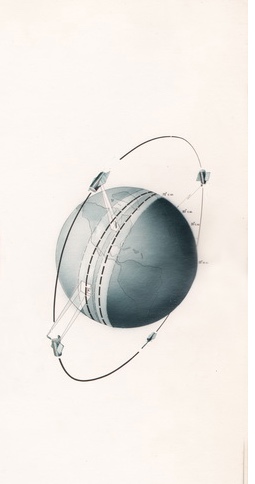 A constellation of four TGR satellites in polar orbit. (Source) |
Targets for observation included ICBM and strategic bomber bases, US Navy ships, ground combat systems, major ports, railways, and transportation hubs. Since TGR’s main goal apparently was to detect preparations for an enemy attack on Soviet territory, the satellites did not need to have the very high resolving power required for technical intelligence of weapons systems. The TV cameras would be equipped with vidicons, small tubes that capture images by scanning a photoconductive surface with an electron beam. To provide the required resolution, they were coupled to advanced optical systems developed by the State Institute of Applied Optics (GIPO) and the Krasnogorsk Mechanical Factory (KMZ).
| The proposals of both design bureaus were reviewed by an interdepartmental commission which was “unable to adopt an independent and objective position” in what it described as the “fierce fight” for the leading role in the project between the two ministries. |
Two configurations of the satellites have been described in some detail, one with a dual payload for observations of land- and ocean-based targets and another with a single payload for observations of land-based targets. In its first configuration, the satellite had a catadioptric optical system (using a combination of lenses and mirrors) called Kometa-11 with a focal distance of 6.5 meters and a ground resolution of 1.5 to 2.5 meters for land observations. The ocean-observing payload was called Mars and had a focal distance of 1.6 meters and a ground resolution of 5 to 10 meters. Also on board would be an electronic intelligence system to detect ships. The second version had a Foton-4 lens with a focal distance of 4.5 meters and a ground resolution of 3.5 to 4 meters.
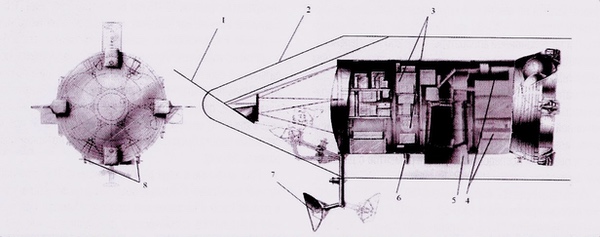 TGR satellite for land and ocean observations in launch configuration. (credit: NPO Mashinostroyeniya). Key: 1. electronic intelligence antenna ; 2. payload shroud ; 3. Mars ocean-observing payload ; 4. TV equipment ; 5. Kometa-11 system ; 6. infrared vertical sensor ; 7. downlink antenna. |
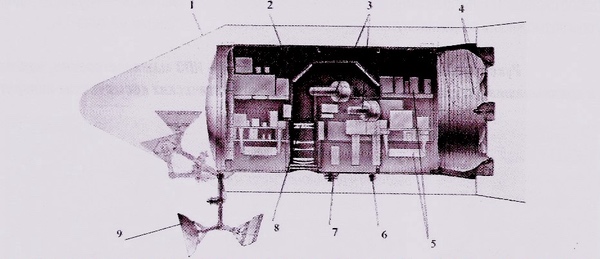 TGR satellite for land observations in launch configuration. (credit: NPO Mashinostroyeniya). Key: 1. payload shroud ; 2. equipment container ; 3. TV equipment ; 4. propellant tanks ; 5. on-board control system ; 6. infrared vertical sensor ; 7. antenna (purpose unknown) ; 8. Foton-4 lens ; 9. downlink antenna. |
Another design of Chelomei’s TGR satellite is seen in the drawing heading this article, an indication that a variety of concepts was studied. This is the only available illustration that shows the satellite in its orbital configuration. Here the optical payload is mounted perpendicularly to the satellite bus and can apparently be tilted. Huge solar arrays extend from both sides of the satellite to feed electricity to its power-hungry TV payload. Also considered was an on-board nuclear reactor not unlike the one already under development at the time for ocean reconnaissance satellites that would use radar to pinpoint the location of foreign naval vessels. Weighing roughly 10 tons, the TGR satellites would be launched by a two-stage version of Chelomei’s UR-500/Proton rocket, which made its maiden flight in July 1965.
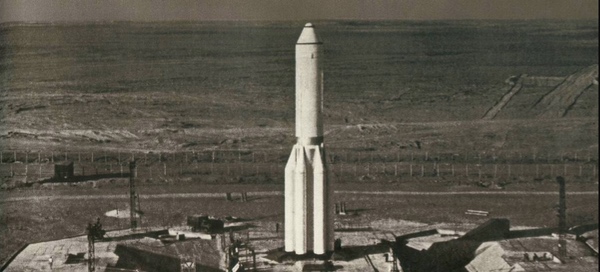 The original two-stage version of the Proton rocket. (credit: NPO Mashinostroyeniya) |
The conceptual study completed in September 1965 noted that while there was a good chance of developing the low-resolution ocean observing payload in a relatively short period of time, much more time would be needed to build the high-resolution land-observing systems. Meanwhile, political upheaval and interdepartmental squabbles were threatening to stop the project dead in its tracks. Chelomei’s bureau had lost much of the support it had enjoyed from the Kremlin after the ousting of Khrushchev in October 1964. As part of a major shakeup of the Soviet space industry in 1965, Chelomei was forced to relinquish control of three of his military satellite projects (ocean surveillance, early warning, and killer satellites) to the OKB-41 design bureau of Anatoliy Savin, which was part of a larger organization called KB-1 that reported to another ministry than Chelomei’s bureau. OKB-41 had already served as a subcontractor for OKB-52’s military satellites (including TGR), being in charge of onboard and ground control systems. Now the roles were reversed.
Although TGR remained in the hands of OKB-52, OKB-41 came up with an alternative proposal for the satellite system. According to a history of Russia’s Military Space Forces, the proposals of both design bureaus were reviewed by an interdepartmental commission which was “unable to adopt an independent and objective position” in what it described as the “fierce fight” for the leading role in the project between the two ministries. As a result, work on TGR gradually came to a standstill. Another reason given for the project’s premature end was the fact that the Soviet Union’s “scientific, technical and industrial base” was simply not ready at the time for a project of this complexity.[4] No precise date for TGR’s cancellation has been given by Russian sources.
Chelomei’s TGR project did produce one important spin-off. The Kometa-11 optical system was modified to fly on Almaz (“diamond”), a military space station conceived by OKB-52 in 1964 in response to the US Manned Orbiting Laboratory (MOL). Called Kometa-11a, it had a focal distance of 6.375 meters and a mirror with a diameter of 0.88 meters and became part of a large camera system known as Agat-1, which occupied a significant portion of the station’s interior.
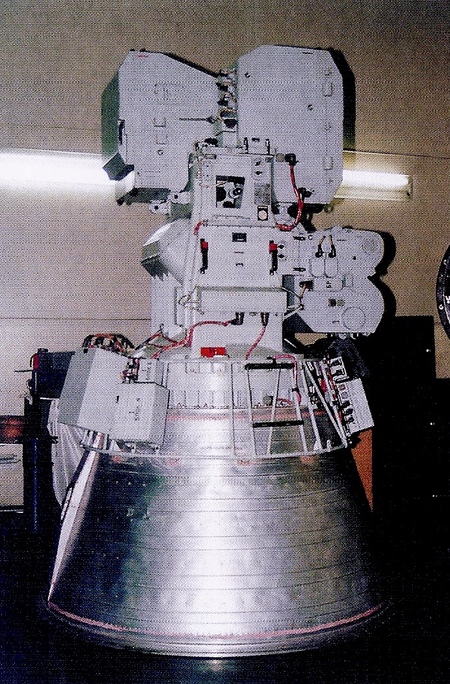 The Agat-1 camera. (credit: NPO Mashinostroyeniya) |
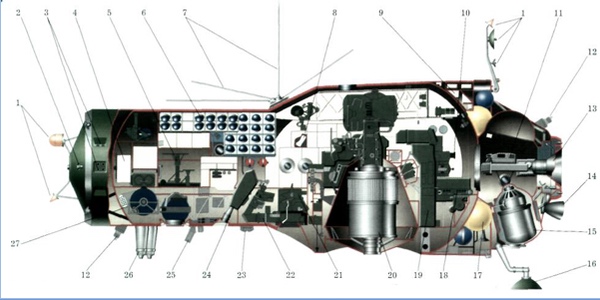 The Agat-1 camera can be seen in position 20 in this cutaway drawing of the Almaz space station. (Source) |
Most of the images obtained by the Agat-1 camera wеre delivered to Earth in film return capsules installed aboard the stations. However, the cosmonauts were also able to develop the most interesting images on board and relay them to ground stations using a film readout system (Pechora), something that had also been considered for MOL missions. Unlike MOL, Almaz did make it into orbit. Three of the stations were launched under the cover names Salyut-2 (1973), Salyut-3 (1974), and Salyut-5 (1976). While Salyut-2 failed in orbit before the arrival of the first crew, Salyut-3 and Salyut-5 hosted one and two crews respectively.[5]
On October 15, 1971, the Soviet government issued a decree ordering the resumption of work on television reconnaissance satellites. Russian sources have given no reasons for this, but even at this point electro-optical imaging satellites employing CCD technology remained such a distant dream for the Soviet Union that it was seemingly considered worthwhile to give TGR another shot. The fact that the decree came at the same time as the top-secret US decision in late 1971 to press ahead with the KENNEN satellites was almost certainly coincidental. Still, Soviet planners were undoubtedly aware of the fact that the US microelectronics industry was far ahead and must have realized that the US would field such satellites much sooner. Therefore, some kind of response was needed to bridge the gap to the Soviet Union’s own electro-optical spy satellites.
Another factor that may have come into play was the high launch rate of Soviet film-return satellites. Despite improvements in the performance of the Zenit satellites, they could stay in orbit for no longer than two weeks, requiring a high number of launches to ensure continuous coverage of critical areas. In 1971 alone, nearly 30 of the Zenit-class satellites were placed into orbit. The TGR satellites could at least somewhat alleviate the heavy burden that the film-return satellites were placing on the Soviet space industry.
| In 1971 alone, nearly 30 of the Zenit-class satellites were placed into orbit. The TGR satellites could at least somewhat alleviate the heavy burden that the film-return satellites were placing on the Soviet space industry. |
The October 1971 decree assigned the new TGR project to two design bureaus, KB Yuzhnoe and OKB-41. KB Yuzhnoe was a design bureau based in Dnepropetrovsk (Ukraine) that was headed by Mikhail Yangel until his death on October 25, 1971, just ten days after the release of the new TGR decree (he was replaced by Vladimir Utkin.) It had been founded as OKB-586 in 1954 to construct a new generation of intermediate and intercontinental ballistic missiles and, in the early 1960s, had also been tasked with designing a wide range of satellites for both military and scientific purposes. OKB-41, still led by Anatoliy Savin, would split off from KB-1 in 1973 to become the independent TsNII Kometa in 1973. Virtually all that is known about the revived TGR project comes from the memoirs of OKB-41 veteran Konstantin Vlasko-Vlasov and a history of the KB Yuzhnoe design bureau.[6]
These sources provide conflicting information. Vlasko-Vlasov claims that the 1971 decree did not appoint a prime contractor and that KB Yuzhnoe and OKB-41 were asked to propose their own concepts on a competitive basis. As described by Vlasko-Vlasov, KB Yuzhnoe put forward a ten-ton satellite that needed to be launched by the Proton rocket, whereas OKB-41’s proposed satellite weighed no more than five tons, remaining within the launch capacity of a Soyuz-class launch vehicle. Both satellites would draw power from a nuclear reactor, but KB Yuzhnoe later switched to solar panels and lowered the mass to “slightly less than 10 tons.” Novelties of the OKB-41 satellite included a TV system incorporating some early CCD technology, the use of integrated circuits and microprocessors, and a digital recorder to store the obtained images.
With its lower mass and advanced technical features, the OKB-41 satellite seemed like the obvious choice, according to Vlasko-Vlasov. However, in his words, an interdepartmental commission tasked with selecting one of the two proposals “began looking for shortcomings” in the OKB-41 proposal, one of which was that the radiation emitted by the nuclear reactor could affect the on-board TV systems. OKB-41 joined forces with the Kurchatov Institute of Atomic Energy to prove that the problem could be solved by using special radiation-hardened optical glass. Nonetheless, the commission picked the KB Yuzhnoe proposal and while some elements of the OKB-41 proposal were used in the design, the design bureau was banned from further work on the TGR system. In Vlasko-Vlasov’s words, this “incomprehensible decision” resulted in the project ultimately being terminated after only three years.
The KB Yuzhnoe history, which mentions OKB-41’s involvement only in passing, confirms that its original plan was to build a nuclear-powered satellite featuring such elements as electric propulsion, a highly capable thermal control system, and an autonomous navigation system. When the military customer reviewed KB Yuzhnoe’s preliminary design, it concluded that the development of the nuclear reactor had not advanced far enough for it to be used in the initial phase of the project. Instead, the satellites would have to rely on solar power, even though that would affect some of their operational capabilities.
KB Yuzhnoe subsequently redesigned the satellite “in a short period of time” and its lower mass now made it compatible with a new medium-lift launch vehicle that the bureau was working on under the name 11K77, eliminating the need to use the more expensive Proton. After undergoing several design changes, the rocket was approved in March 1976 and would later become known to the world as Zenit (not to be confused with the identically named film-return spy satellites.)
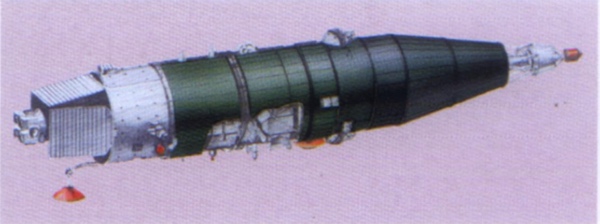 The nuclear-powered version of KB Yuzhnoe’s TGR satellite. (credit: KB Yuzhnoe) |
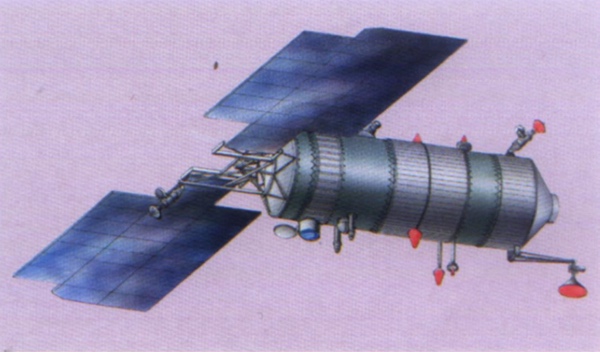 The solar-powered version of KB Yuzhnoe’s TGR satellite. (credit: KB Yuzhnoe) |
The Yuzhnoe history states that the redesigned KB Yuzhnoe satellite was favored over the OKB-41 proposal, adding that by that time OKB-41 had been assigned as the lead organization for TGR, with KB Yuzhnoe being responsible for the “rocket and space complex.” It attributes the end of KB Yuzhnoe’s involvement in TGR only to the design bureau’s heavy workload, not clarifying when exactly the design bureau withdrew from the project.
With only two biased accounts available, it is difficult to reconstruct the true history of the second TGR project. Most likely, OKB-41 was supposed to play the same role in TGR as the one it had acquired in several other military space projects in 1965. While it acted as the lead organization for those projects, it did not have the production facilities to build the satellites, mainly limiting itself to the development of on-board control systems and ground control hardware. As a result, the production of the satellites had to be entrusted to other organizations.
A similar division of labor was presumably envisaged for the second TGR project, with OKB-41 serving as prime contractor and KB Yuzhnoe delivering the launch vehicle and the satellite bus (the “rocket and space complex”, as it is called in the Yuzhnoe history.) It does appear that both offered competitive designs for TGR from which the KB Yuzhnoe design was eventually selected. An important factor in that decision may have been Yuzhnoe’s switch from a nuclear-powered to a solar-powered satellite, a move that OKB-41 does not seem to have made.
The second TGR project was officially terminated by a government decree on January 19, 1976. On exactly the same day, a decree was passed that laid out a schedule for Chelomei’s Almaz project in the following years. Most likely, it was the very same decree that axed TGR. Among other things, it called for developing two automated versions of Almaz (Almaz-K and Almaz-T) that would perform tasks that were beyond the capabilities of smaller reconnaissance satellites at the time.
| The January 1976 decree set the goal of building three Almaz-T stations to carry out test flights beginning in 1978. Once the spacecraft was declared operational, the hope was to simultaneously fly three or six of them in three different orbital planes. |
Almaz-K would make high-resolution panoramic images of large swaths of territory, mainly to keep an eye on local conflicts and crisis situations. Staying in orbit for about three months, it would regularly send back exposed film in as many as 16 to 20 return capsules. Almaz-T was to be capable of peering through clouds and making nighttime observations by using both a radar system and an infrared payload. In addition to that, it would carry a TV system based on the one originally planned for the second TGR project. All these payloads would transmit imagery via radio channels, ensuring the data was in the hands of photo interpreters within hours of being obtained. Almaz-T’s main goal was to look for potential signs of an imminent attack on Soviet territory by closely monitoring airfields, naval bases, transportation hubs, and other strategically important targets. Essentially, it was to perform the same function as TGR, but the vehicle’s 20-ton mass made it possible to do this with a broader suite of remote sensing instruments operating in various parts of the electromagnetic spectrum.
With the approval of Almaz-T and its TV payload, television-based reconnaissance returned to Chelomei’s design bureau, which in 1966 had been renamed the Central Design Bureau of Machine Building (TsKBM). Almaz-T’s TV payload was called Lider (“leader”) and was built by an industrial team led by the All-Union Scientific Research Institute of Television (VNIIT) in Leningrad, the same institute that had worked on the original TGR project in the 1960s under the name NII-380. The man placed in charge of Lider was VNIIT veteran Igor Valik, who had also supervised the development of the Baikal and Pechora film readout systems. According to a history of VNIIT, the institute had begun working on Lider in 1973, suggesting that it was originally intended to fly on the TGR satellites. It is possible, though, that it underwent significant modifications after being transferred to Almaz-T.
Lider occupied the same place where the Agat-1 camera had been on the crewed Almaz stations and looked down at Earth through a 40-centimeter porthole. Its optical system, provided by the Krasnogorsk Mechanical Factory, was named Izumrud (“emerald”) and featured a lens (Telegoir-12MT) with a focal distance of three meters. Тhe light beam entering the optical system was split into three parts using a set of mirrors and subsequently entered three simultaneously operating television cameras (LR-103) with vidicon tubes named Kolos (a product of VNII Elektron.) These operated in the red part of the visible spectrum (600–700 nanometers) and each had a resolution of 4,000 TV lines. The images were recorded on a three-channel video recorder (RD-101) built by LOMO in Leningrad. When the spacecraft passed over Soviet territory, the three separate images were relayed to the ground, where they were combined into a single image. Lider was also capable of directly sending images to Earth (without recording them) if it made its observations while in range of Soviet ground stations. Lider covered a swath of 18 kilometers, but this could be increased to 500 kilometers by turning the spacecraft with respect to its longitudinal axis. The ground resolution varied between two and five meters depending on the observation conditions.
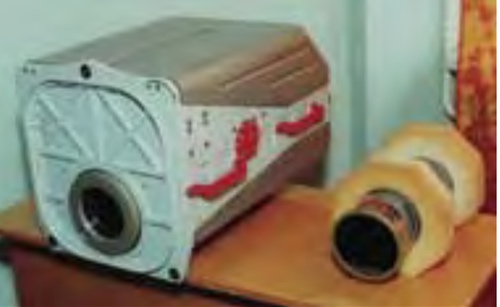 Fuzzy image of the LR-103 television camera and its Kolos vidicon tube. (credit: NIIT) |
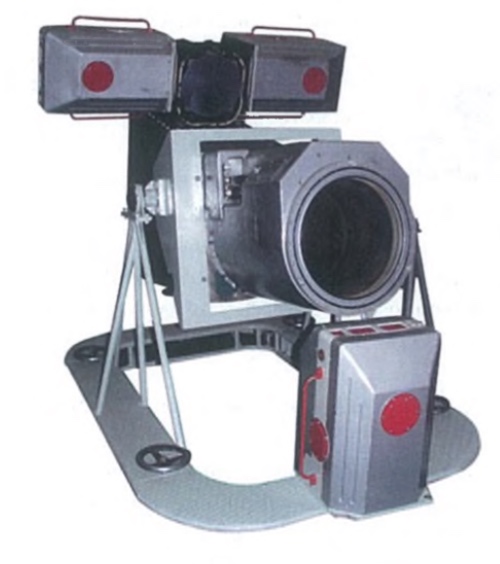 Izumrud, the optical component of Almaz-T’s Lider payload. (Source) |
The January 1976 decree set the goal of building three Almaz-T stations to carry out test flights beginning in 1978. Once the spacecraft was declared operational, the hope was to simultaneously fly three or six of them in three different orbital planes. However, by the late 1970s the military’s enthusiasm for Almaz had significantly cooled, one important reason being the strained relations between Chelomei and Defense Minister Dmitriy Ustinov. In June 1978, the Ministry of Defense decided to terminate work on piloted Almaz stations and in December 1981 it also canceled both Almaz-K and Almaz-T. The first Almaz-T station, which was already undergoing launch preparations at the Baikonur cosmodrome, was mothballed.
In an ironic twist of fate, both Chelomei and Ustinov passed away in December 1984, setting the stage for the resumption of the Almaz-T project. Gerbert Yefremov, the new head of the design bureau (renamed NPO Mashinostroyeniya in 1983), managed to persuade the Soviet leadership to revive Almaz-T by arguing that the US had taken the lead in space-based radar monitoring of the Earth. After a launch failure on November 28, 1986, two of the stations reached orbit on July 25, 1987 and March 31, 1991, under the official names Cosmos-1870 and Almaz-1. They were placed into low-altitude orbits at inclinations of 72 degrees that offered better coverage of the Earth’s surface than the 51.6-degree inclination orbits used by the crewed Almaz stations. Cosmos-1870 spent two years in orbit and Almaz-1 about 1.5 years.
| By the time the long-delayed Almaz-T stations finally flew, the TV technology was already outdated. |
Publications at the time only acknowledged the presence of the radar system. The fact that the stations had also carried a television payload was not disclosed until many years later (the originally planned infrared payload had seemingly been dropped at an early stage.) Nonetheless, even more than three decades later, very little has been revealed about the performance of Lider and none of its pictures have ever been released. It reportedly made a large number of images for both military and civilian purposes and was capable among other things of identifying various types of aircraft sitting on the ground.
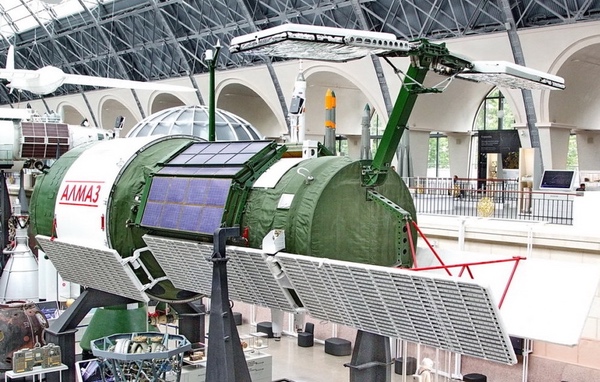 A model of Almaz-T with its side-mounted radar antenna on display at the Cosmos pavilion in Moscow. The big antenna on top was used to relay imagery via data relay satellites. (Source)
|
By the time the long-delayed Almaz-T stations finally flew, the TV technology was already outdated. In December 1982, the Soviet Union had begun launching electro-optical reconnaissance satellites with CCD technology. They equaled or surpassed the two-meter ground resolution offered by Lider and also sent back images in near-realtime via geostationary data relay satellites (a capability demonstrated only by Almaz-1.) Numerous accounts suggest that the Ministry of Defense had largely lost interest in Almaz-T and that the second station in particular was primarily used for civilian remote sensing. When Almaz-1 was deorbited on October 17, 1992, the era of space-based television reconnaissance came to a definitive end.[7]
As the launch rate of the digital satellites increased, the film-return satellites were gradually phased out, with the last one going up in 2015. Still, to this date Russia has not accomplished the goal that the Soviet Union set out to achieve with TGR back in the 1960s, namely to deploy a large fleet of simultaneously operating optical reconnaissance satellites capable of providing timely intelligence and near continuous coverage of critical regions on Earth. At the present time, Russia appears to have only one operational high-resolution electro-optical reconnaissance satellite in orbit: Cosmos-2506, a satellite of the Persona type. Having been launched in June 2015, it has most likely exceeded its design lifetime by a significant margin. A new generation of both big and small reconnaissance satellites (named Razdan and Razbeg) is yet to make its appearance.[8]
Note: we are using a new commenting system, which may require you to create a new account.